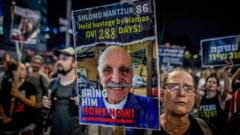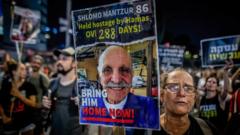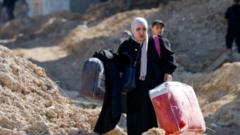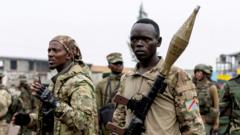As thousands of displaced Gazans return home after 15 months, they confront a landscape marked by devastation and uncertainty. The immediate needs for shelter and resources are exacerbated by the scale of destruction, leaving many in ongoing displacement. With the situation intensifying, questions arise about the long-term future of those returning to a broken homeland.
Gaza's Path to Recovery: A Journey from Ruin to Rebuilding
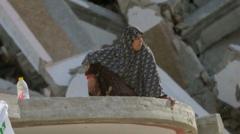
Gaza's Path to Recovery: A Journey from Ruin to Rebuilding
Amidst overwhelming destruction, Gazans embark on a tentative journey back home, facing immense challenges as they rebuild their lives from scratch.
In the wake of a devastating conflict, the journey home for many Gazans has reluctantly begun after being displaced for 15 months. Although the Gaza Strip is geographically small, this trek marks the onset of a profoundly precarious future for its residents. "The scale of the looming humanitarian challenge is hard to comprehend," warned Ghada el-Kurd, a Gazan journalist returning north from Deir el-Balah, where she sought refuge. "We have to re-establish again from the beginning, from zero."
The immediate needs for food and shelter are being met with an influx of aid, a welcome change after a long period of suffering. According to Sam Rose from the UN's Palestinian refugee agency, Unrwa, the organization is working tirelessly to provide the essentials, including food, water, blankets, and hygiene items. Despite these efforts, the extensive task of rebuilding is daunting, as the infrastructure needed to support a functional society is in ruins.
The destructive impact of the war is staggering; estimates suggest that 70% of buildings within the Gaza Strip have been either damaged or outright destroyed since October 2023. Significant areas like Jabaliya, which housed a population of 200,000, have seen complete destruction, leaving those returning to find their homes obliterated. The call for urgent aid is palpable, with Gaza's government appealing for 135,000 tents, while the demand for shelter continues to escalate.
As families return, new layers of complicated displacement emerge, especially as those who stayed in the north are faced with accommodating returning refugees. In Ismael Tayeh's building, for instance, a mix of families is already causing tensions due to the cramped living conditions. Further complicating the already critical shortages, rising market prices for basic goods are evident, driven by increased demand from returning residents.
Despite the hardships that lie ahead, some returning residents express a sense of relief and hope. "We are overjoyed to return to the north, where we can finally find comfort," a woman shared, embracing the opportunity to reclaim their dignity after prolonged suffering.
Outside perspectives, particularly from political figures like Donald Trump, propose controversial solutions regarding resettlement in neighboring countries, causing tensions among regional leaders. Critics, including Jordan's Foreign Minister, emphasize their nation is meant for Jordanians, not for absorbing displaced Palestinians.
As Gazans return to a landscape of desolation and challenge, a critical juncture awaits. The long-term future of these individuals lies in the balance, hinging on effective rebuilding, international support, and a sustainable vision for peace in the region. The possibility of continued out-migration looms for many, with fears that if Gazans do not see hope for a better future, a mass exodus to the Arab world or beyond may be imminent. "Why not in Gaza?" Ghada el-Kurd wisely poses, echoing the collective sentiment for a home rebuilt on hope.
The immediate needs for food and shelter are being met with an influx of aid, a welcome change after a long period of suffering. According to Sam Rose from the UN's Palestinian refugee agency, Unrwa, the organization is working tirelessly to provide the essentials, including food, water, blankets, and hygiene items. Despite these efforts, the extensive task of rebuilding is daunting, as the infrastructure needed to support a functional society is in ruins.
The destructive impact of the war is staggering; estimates suggest that 70% of buildings within the Gaza Strip have been either damaged or outright destroyed since October 2023. Significant areas like Jabaliya, which housed a population of 200,000, have seen complete destruction, leaving those returning to find their homes obliterated. The call for urgent aid is palpable, with Gaza's government appealing for 135,000 tents, while the demand for shelter continues to escalate.
As families return, new layers of complicated displacement emerge, especially as those who stayed in the north are faced with accommodating returning refugees. In Ismael Tayeh's building, for instance, a mix of families is already causing tensions due to the cramped living conditions. Further complicating the already critical shortages, rising market prices for basic goods are evident, driven by increased demand from returning residents.
Despite the hardships that lie ahead, some returning residents express a sense of relief and hope. "We are overjoyed to return to the north, where we can finally find comfort," a woman shared, embracing the opportunity to reclaim their dignity after prolonged suffering.
Outside perspectives, particularly from political figures like Donald Trump, propose controversial solutions regarding resettlement in neighboring countries, causing tensions among regional leaders. Critics, including Jordan's Foreign Minister, emphasize their nation is meant for Jordanians, not for absorbing displaced Palestinians.
As Gazans return to a landscape of desolation and challenge, a critical juncture awaits. The long-term future of these individuals lies in the balance, hinging on effective rebuilding, international support, and a sustainable vision for peace in the region. The possibility of continued out-migration looms for many, with fears that if Gazans do not see hope for a better future, a mass exodus to the Arab world or beyond may be imminent. "Why not in Gaza?" Ghada el-Kurd wisely poses, echoing the collective sentiment for a home rebuilt on hope.




